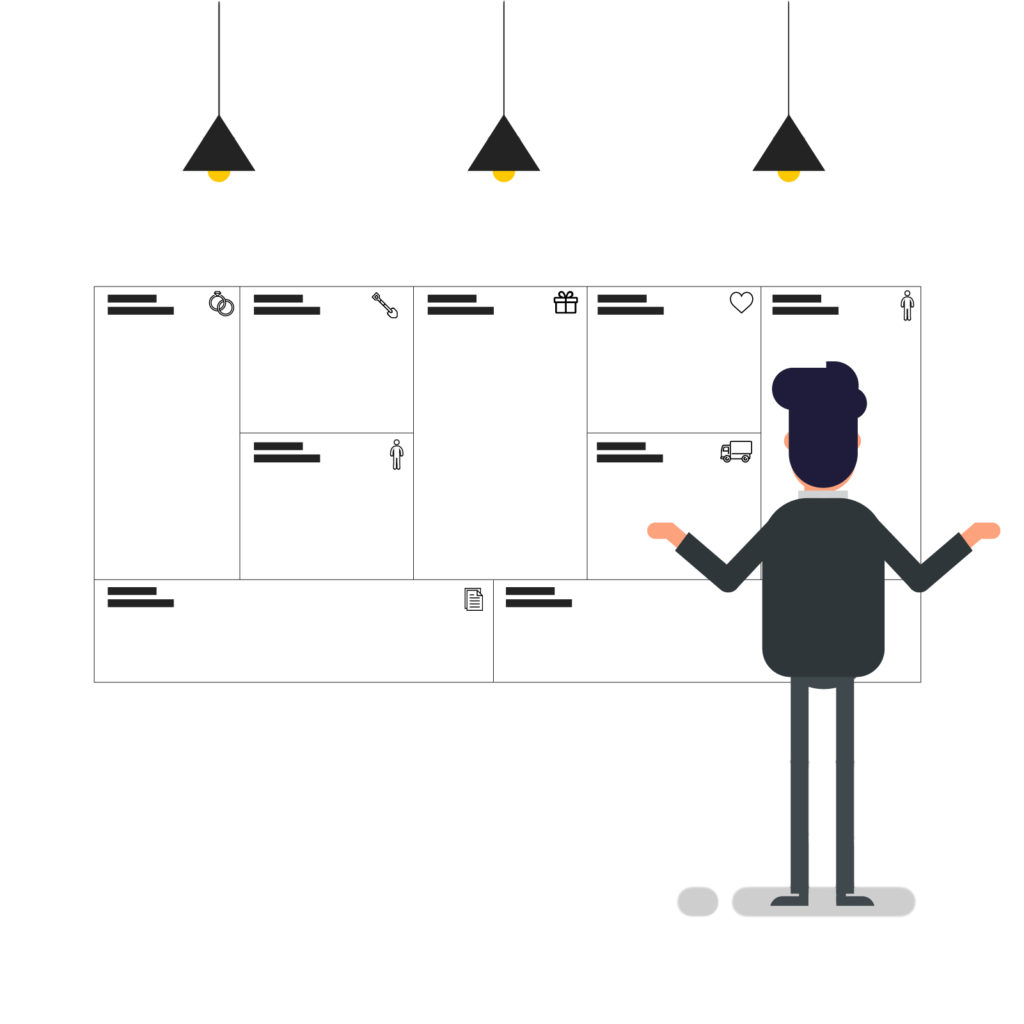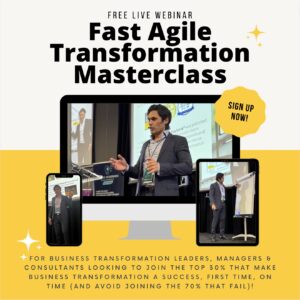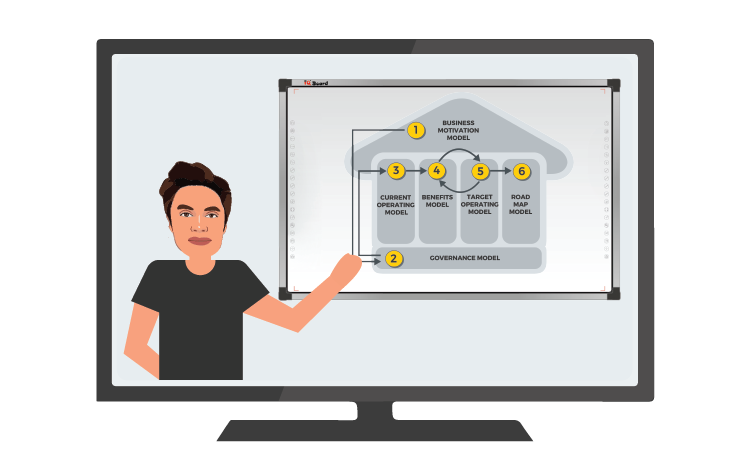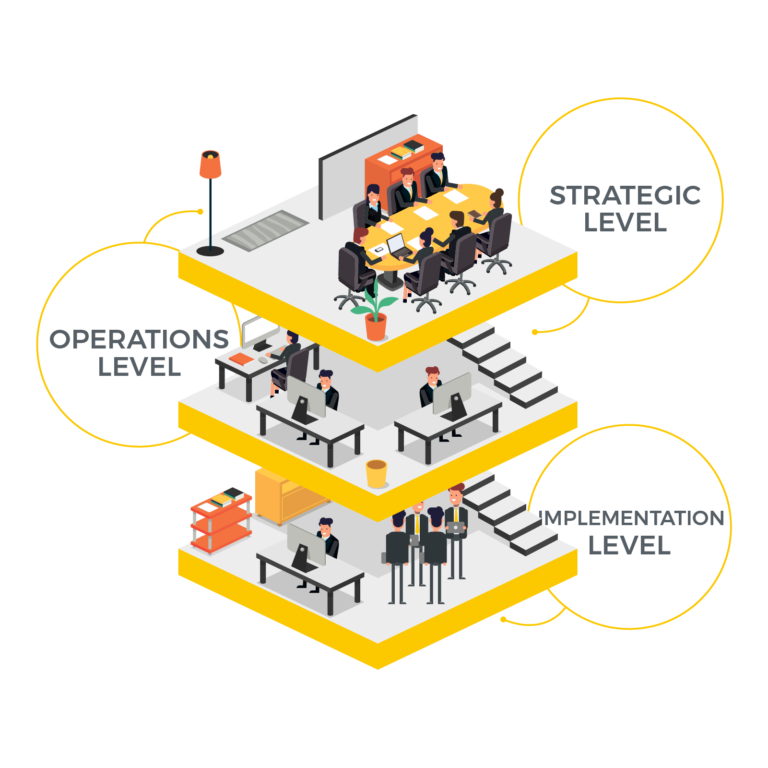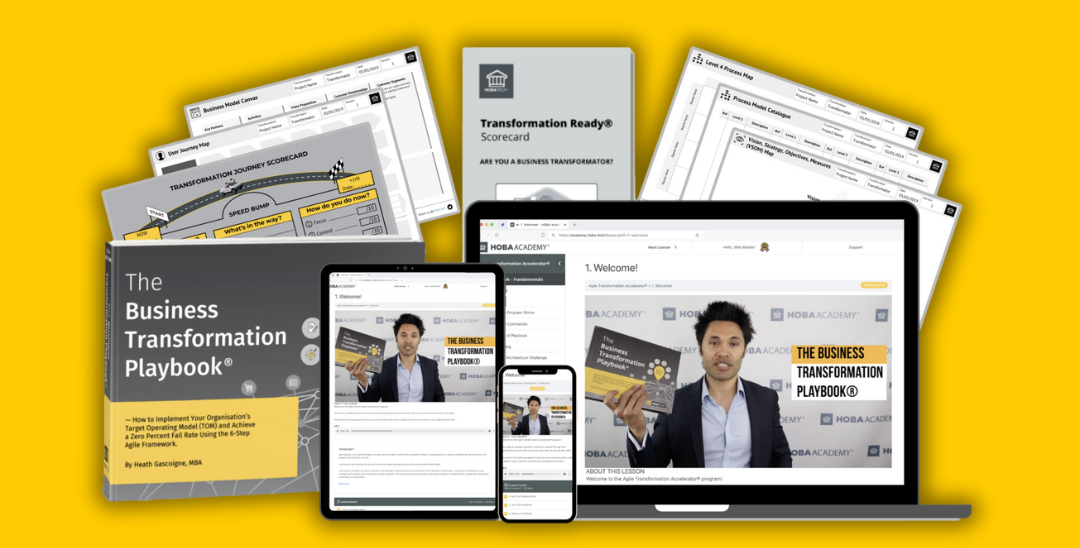In this post we are going to discuss the hype and myth of the Business Model Canvas (BMC).
The BMC is a powerful tool, when in the right hands, used in the wrong way. On the converse, it is a dangerous tool, when in the wrong hands and used the wrong way.
Dangerous in the context of business and digital transformation, it can cost you time, money and missed opportunities.
The Business Model Canvas (BMC) is a powerful tool, in the right hands; dangerous in the context of business transformation, it can cost you time, money and missed opportunities.
Heath Gascoigne Tweet
In this post we are going to get into the details, and discuss the following:
- What is the Business Model Canvas (and it components)?
- When to use it?
- When not to use it?
- How to use it in your business transformation?
What is the Business Model Canvas?
The Business Model Canvas (BMC), developed by Professor Yves Pigneur and Dr Alexander Osterwalder, which was based on Osterwalder’ PhD thesis[1] is a template used to identify the key components of an organisation’s business model.
The BMC is touted as a ‘business on a page’, as it provides on a single page, a conceptual view of the business model components, as shown below:
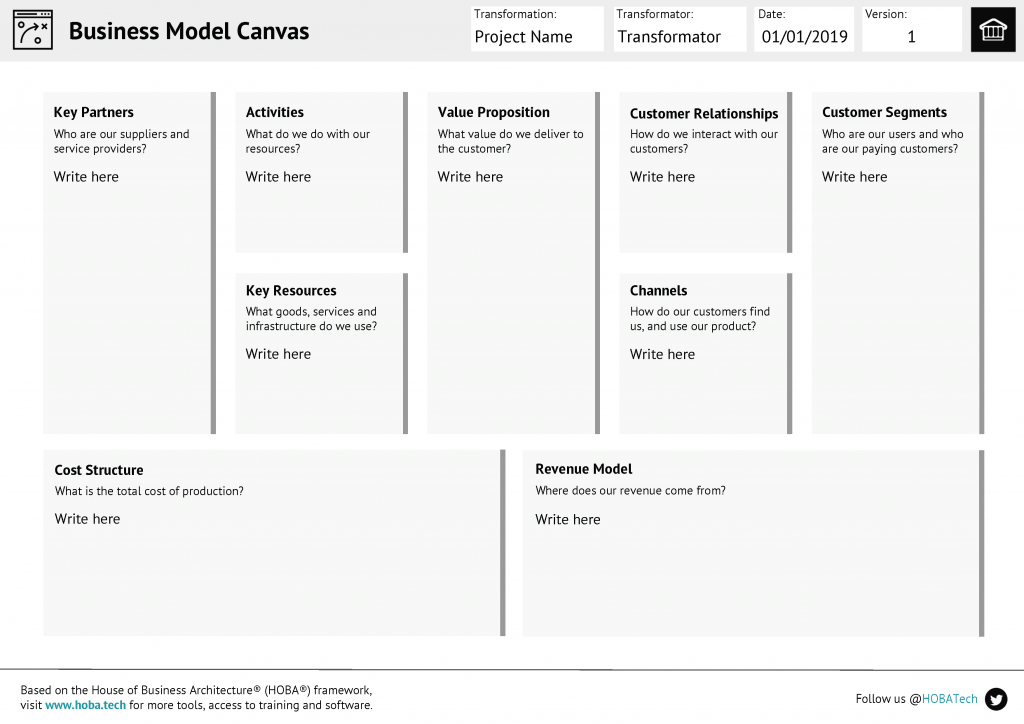
The BMC provides the ability to visualise the key components, that according to the authors should exist. Those key components are as follows:
Value Propositions
- What are you producing (product or service) to meet a demand or need the that market is willing and able to pay.
Customer Segments
- What market or (customer) segments are you targeting?
Channels
- How are you delivering your product or service to your customers?
Customer Relationships
- How are you going to attract and keep your customers?
Revenue Streams
- What methods are you going to use to sell your products and services (e.g. direct sales, freemium, licensing etc. )?
Resources
- What resources do you need to produce and market your products and services?
Key Partners
- what partnerships (ie buyers, suppliers etc.) do you need to deliver your products and services?
Key Activities
- what key activities do you need to do (important activities you need to do to ensure your business runs efficiency)?
Cost Structure
- What are the cost of the different elements you pay for to run your business (i.e. materials, rent, payroll etc.)?
Now the question – in what situations should you use it?
When to use it?
The BMC is best suited for startups or new businesses (not existing business, or business transformations).
To explain why the BMC is best suited for startups or new businesses (and not existing businesses or business transformation), we need to step back, and ask ourselves ‘what are we looking at here?’, and ‘what is the BMC telling us?’
To the naked eye, the BMC is flat, one dimensional. But it does in fact, actually have two dimensions, or ‘levels’ – a conceptual level, and a logical level:
At a Conceptual level:
- The BMC has nine (9) components – components the authors consider ‘conceptually’ necessary as discussed above, that a business should consider in its mission to create value (i.e. create and sell its products and services that customers want or need at a profit – the margin between the revenue received less the cost of goods sold, and the cost to maintain the business, shown across the bottom of the canvas), and
At a Logical level:
- Given you have identified ‘conceptually’ each of the above 9 components of the BMC, and therefore your ‘business model’, how do they ‘logically’ fit together in practice? You don’t actually know, not at this point. You then need to test this concept (or ‘hypothesis’ as Osterwalder at el. call it), that given all the 9 conceptual parts, logically these would fit and work together, and then you will have a viable business model (i.e. could you generate the revenue you expect, with the product and service you will sell, having the key relationships in place, to provide those products/services to your target market using your key activities, to sell it at a profit)?
The idea is to test those hypothesis in the market, like a pilot or MVP in business transformation, on a sample or small subset of your market, to get a ‘finger in the air’ i.e. check the temperature that ‘you are on to something’. The more vigorous the tests, the more confidence in the ‘model’.
This works well for a Startup, when you don’t have a Business, where following a successful testing of the hypothesis (or hypotheses) you get indications of the ‘green light’ i.e. you have a potentially viable business model.
The reason why it works well for a Startup is because, as a Startup, there is no existing business, no existing business model, no existing processes, no existing systems, people (staff or customers) nor product or service. You have the un-inhabited ability to create them (either buy, build or borrow) from scratch.
BMCs are popular right now possibly as a symptom of the heightened ‘Startups’ and ‘Startup activity’ which is ‘topically’ very hot right now.
But we need to be careful, and not to get caught up in ‘startup’ craze right now, and make sure we have got the right tool for the job.
When not to use it?
This brings me to the next and most crucial point. When should you not use (or use with caution) the BMC, which is the second purpose of this post – ‘when in the wrong hands or used in the wrong way, the BMC can cost you time, money and missed opportunities’.
The Business Model Canvas (BMC) is missing the key dimension – implementation, and shouldn't be used (or used with caution) for existing Businesses.
Heath Gascoigne Tweet
Not for implementation
Firstly, as discussed above, in terms of dimensions – the BMC is both conceptual (i.e. it answer the ‘conceptual questions’ – ‘what are the list of elements we need to consider as part of our business model?’), and logical (i.e. it answers the next dimensional question – logic e.g. ‘OK, now you have the list of conceptual elements we need to consider for our business model, how are they going to need to work together?).
The third and most important dimension, the one that is missing with the BMC, which is – implementation.
Designs and models are only worth the paper (or screen) they are written (or created) on – if you can’t implement it. And where do most projects and programmes fail – at Implementation.
Implementation is completely missing from the BMC, but that is OK. It was not intended too.
The BMC is a conceptual tool (a very good one at that), developed to provide a conceptual and logical view of an organisations theorised business model. It was not about how to implement it, nor how to change one that already exists.
This situation is similar to TOGAF® for Enterprise Architecture and Business Transformation. TOGAF® was created, designed and owned by The Open Group (we covered this in a previous post). The Open Group is a “technology standards company”, as it states clearly on their website today, and for many years.
TOGAF® is all about how to maintain and/or change “technology”, mostly enterprise-wide/enterprise-level applications. It is not about how to maintain and/or change “Business” or Business Transformation. It was never set up for that, and shouldn’t be used for that. You need the right tool for the job.
Besides implementation, what else is the BMC missing?
The BMC is missing two (2) crucial factors:
- BMC is not about how the Organisation needs to be structured (i.e. its Business Architecture) that will be supporting those elements in the business model, and
- BMC is more importantly not about how are those nine (9) key business model components are going to be or need to be implemented, not least, where they already exist (in an existing Business, not a ‘model’ of a Business, that only exists on paper or a screen), nor including how does the business ‘transform’ from its current operating model, to its future operating model.
The implementation aspect is completely missing from the BMC, but that was not the point of the BMC.
The point of the BMC was as mentioned earlier – is to identify conceptually what are the nine (9) elements of the organisations business model; and then logically how would they work together in practice.
The BMC will tell you (or hypothesise) what are the key components of an organisation’s business model, at least in name – what they should be, and then at best, how they will interact with each other – conceptually and logically.
Not for existing Business
Which leads to the second point, so it the BMC is good for Startups and new businesses, then what type of business is the BMC not good for?
What the BMC is not good for is existing businesses.
For an existing business, it’s a different story. You have an existing business, an existing business model (albeit it might be broken, and/or in need of transforming), existing processes, existing systems, existing people (staff and customers), existing culture and existing products and/or services.
Trying to ‘move or ‘transform’ these existing components from the ‘current’ business model to the ‘new’ or ‘future’ business model is not as easy as flicking a light switch, from off to on and you have a ‘new’ business model’.
Firstly, it’s not actually a new Business Model you would be creating for an existing business. What you would be creating is actually a new Business Strategy.
If you are an existing business, what you are asking of the Business Architect (we call Business Transformators – because a Business Transformator has moved beyond Designer, to include part Strategiser, part Collaborator and part Negotiator) to come up with a new business strategy, and then how does the Business need to transform, to align to the new strategy.
The Business Model Canvas (BMC) is not the tool you need or should use. It is the wrong tool for the job.
The Business Model Canvas (BMC) is not the tool you need or should use when transforming an existing business. It is the wrong tool for the job.
Heath Gascoigne Tweet
The business model considers all the parts of the organisation that need to exist in order to provide its products and services to the market, at a profit for the company. The business strategy is the method the company is using to achieve the company’s number one objective, its Vision.
As an existing Business, if you start off with the Business Model Canvas, you are at risk of just creating ‘work-for-works’ sake.
This is what in management consulting terms is called ‘boiling the ocean’, something highly paid consultants are trained to say ‘we’re not trying to (or going to) boil the ocean’ to the client, meaning – they will not create work for works sake, or ‘documentation for documentations’ sake, then do the that exact opposite, and create reams and reams of documentation!
Creating ‘documentation for documentations’ sake not only takes a long time to put together, but also a long time to not only get reviewed, but to then get it approved, which in most cases, only just becomes “interesting, but not useful”.
This is the dangerous part.
If that happens, you are at risk. You are at risk that you will burn through valuable and sometimes irreplaceable time, money, resources and miss opportunities to create something that is both not needed, but only just becomes ‘interesting, but not useful’.
How to use it in your Business Transformation?
I see a lot of Business Architects, Business Designers and even Business Analysts run to the BMC as the alleged ‘panacea’ and first step when it comes to transforming the business.
When it comes to business transformation, and transforming your business, or business model for that matter, before you jump into any deep dives of activities or work in fear of the ‘burning platform[1]’ you need to agree on one (1) thing for yourselves and the Client:
Only do what needs to be done to transform the business (e.g. develop the design and roadmap to Implement the physical changes the design describes).
"In Business Transformation, we should only do what needs to be done to transform the business - not create pretty presentations which are interesting but useless"
Heath Gascoigne Tweet
That means, you should only create the minimum amount of work (and documentation) required to both develop the design, and implement the physical changes the design describes (and most importantly) otherwise you will end up creating ‘work for works sake’ (or ‘documentation for documentation’s’ sake) which only just becomes ‘interesting but not useful’.
The tell-tale sign that you are either creating work for works sake (or are victim of it), is if you have a whole room dedicated to artefacts attempting to describe the details of this business model (aptly called a ‘war room’[2] to display such artefacts, which you are told is ‘needed’ – needed to justify the creation of such artefacts to fill up the every last square inch of wall!).
Worse, the pinning up of those or new version of those artefacts is celebrated with great bravado, as if that was what the program was (solely) responsible for delivering (and not the physical changes into the Business, which it is if we’re honest)!
If you find that is the situation, you need to ask the question ‘what are they used for and how do you actually use them?’ or…
You should stop that work now, because the outcome after spending months and months on it, to get them drafted, reviewed and approved (with key stakeholders whom are not entirely sure what they are signing off, the packs are 300 slides long, they will sign off anything that that point!), is going to end up wasting time, money and resources, and missing opportunities working on developing and producing something that is only ‘interesting but not useful’.
If you are an business owner or business leader, what you need to do, or insist on happening, is that you need to develop two (2) things:
- Develop your new business strategy (if not done already) and/or
- Develop the new target Business Architecture (we call TOM – the Target Operating Model) that addresses the problems and opportunities in the organisations current Business Architecture (i.e. current operating model) today, and the future, within scope, budget, timeline and risk the organisation is willing to accept, AND the roadmap to implement those changes to align the critical elements of the Business (i.e. Business Architecture) to your new strategy.
These elements of the Business are the organisation structure, the people, user journeys, the processes that support those journeys, and the business capabilities those processes support. We call that your Business Architecture.
Your Business Architecture is how your organisation needs to be structured and changed from the current operating model, to the future operating model, in order to effectively and efficiently execute that new strategy, and how to effectively and efficiently implement your business’ transformation.
This is where you need to spend the time.
This is also where in developing this new future operating model you test the ‘hypothesis’ of this model, that future operating model it actually viable, through a Pilot, before developing and implementing the physical changes into the organisation.
This is the approach you need to be following, and not wasting time, money and resources on developing artefacts, and business models that end up just become ‘interesting but not useful’.
These are the critical aspect of the business, and Business Architecture that need to be understood, captured and agreed.
If you are an Business Owner or Business Leader of an existing business and you or your Business Architect, Business Designer or Business Analyst (or consultant or consultancy) is insisting on developing your Business Model via a BMC, you need ask why?
The devil is always in the detail.
What you need to be asking about or worrying about is implementation. How is the business structured (i.e. the Business Architecture) and set up to deliver the new Business Strategy; how do you transform from the current operating model to the new future operating model, and when and how will it be implemented.
To request or insist on developing the BMC when it is not needed or required is only going to be developing something that is ‘interesting but not useful’.
Much success with your Business Transformation!
Thank you for reading this!
Sincerely,
Heath Gascoigne
P.S.: The Business Model Canvas (BMC) does has its place in Business Architecture and Business Transformation (as part of the Organisations Business Motivation Model), you can download the FREE Business Model Canvas (BMC) Blueprint here.
P.P.S.: If you want to join our Business Transformation community of like-minded Business Transformators, join the community on the Business Transformation Facebook Group here.
P.P.P.S.: If you want to learn more about the world’s only business-led business transformation framework, check out The Business Transformation Playbook here.
For more information, visit https://hoba.tech

